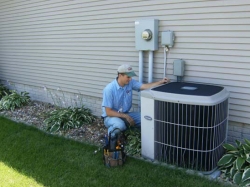[Blog] Which Refrigerant Has The Lowest GWP?
Energy Disrupter

Knowing which refrigerant has the lowest GWP is key for HVAC professionals looking to guide clients in a more compliant direction. Photo by: hvacwoodbridge.org Hvac-Service-Brooklyn-NY
As you probably know, 2020 will see the Environmental Protection Agency (EPA) implementing stricter rules concerning refrigerants in the United States. Specifically, HCFC refrigerants will no longer be produced in or imported into the United States. Knowing which refrigerant has the lowest GWP will allow HVAC contractors to take the opportunities that this shift allows.
What Is Low GWP Refrigerant?
Before we get too deeply into this topic, let’s cover the basics. What is low GWP refrigerant in the first place?
Refrigerant GWP values represent a given product’s Global Warming Potential. The higher the score, the more damaging the product is believed to be for the environment. Experts typically discuss GWP scores based on the projected impact over 20 years, 100 years, and lastly 500 years.
R-22’s GWP over 100 years is 1,810 according to the California Air Resources Board. As such, it should come as no surprise that R-22 (the world’s most common refrigerant today) is among those being clamped down against by the EPA.
Even refrigerants (like R-404A) that haven’t historically drawn the ire of regulators are poised for future clampdowns thanks to high GWP scores.
Which Refrigerant Has The Lowest GWP?
According to the California Air Resources Board, that would be R-717, which has a 100-year GWP of 0. R-717 goes by the trade name Ammonia, which has been around since the 1930s. Experts today recognize it as the most efficient refrigerant in the world. In addition to its 0 GWP, R-717 has a 0 Ozone Depletion Potential as well.
Now that you know the refrigerant with the lowest GWP, here are some other options:
- R-134ze(E): GWP = 1
- R-1224yd(Z): GWP = 1
- R-744: GWP = 1
- R-1234zd(E): GWP = 1
- R-514A: GWP = 2
- R-290: GWP = 4
- R-600a: GWP = 5
- R-170: GWP = 6
- R-601: GWP = 11
- R-161: GWP = 12
- R-123: GWP = 77
- R-225ca: GWP = 122
- R-152a: GWP = 124
Each of these refrigerants is low GWP per the California Air Resources Board.
What Factors Affect Refrigerant GWP Values?
It’s not just refrigerants that receive GWP values. Really any gas can be placed on the GWP spectrum (R-22, for example, has a GWP 2,000x that of carbon dioxide).
Carbon dioxide is the gas that experts use as a benchmark for understanding how different gasses affect the environment. Factors that influence how a given gas scores include:
- its absorption rate
- how long it ‘lives’ in the atmosphere
- at what wavelength the gas absorbs radiation
Are GWP Values Universally Accepted?
The GWP is a metric, much like the S&P500 is a metric (well, technically an index, but the analogy still holds) of the U.S. stock market.
And just like you will find people debating whether or not the S&P500 (or even the stock market) is a suitable measure of the U.S. economy, there are plenty of people who debate the veracity of GWP values as they pertain to environmental impact.
It’s worth pointing out that GWP values are very dynamic. Experts are always adjusting them based on new understandings of how different gasses behave and interact with the environment.
Whether or not you decide to make GWP values a substantial part of your business plan going forward, they’re not going away anytime soon. At the very least, having a working knowledge of them will help you better communicate with your fellow industry professionals and well-informed clients.
Another metric to familiarize yourself with is GTP or Global Temperature Potential, which takes a slightly different approach to understand the environmental impacts of gasses.
One thing we do know for certain is that HCFCs do impact the environment negatively, which is why their use is being prohibited. Exactly how you measure that impact is the subject of debate.
Conclusion
The refrigerant with the lowest GWP (Global Warming Potential) is R-717. There are many other low-GWP refrigerants out there, meaning you as an HVAC professional should have no trouble finding one right for the applications you deal with.
Whether or not GWP values become a major part of how your company functions, we hope this article has been helpful for providing a brief overview of what they are and how they impact refrigerants.
learn more
Identifying the refrigerant with the lowest GWP is incredibly valuable for HVAC companies (especially those in hot climates like Arizona-based American Home Water and Air) looking to position themselves well for the future.












